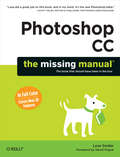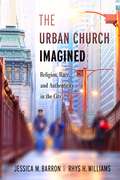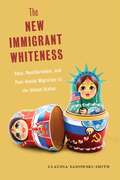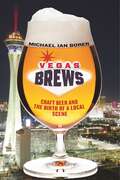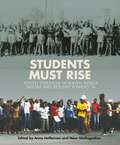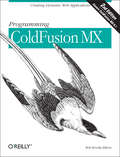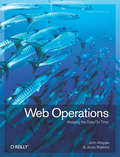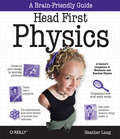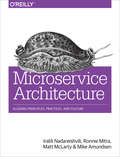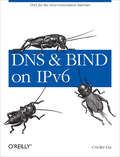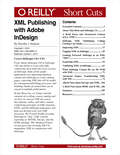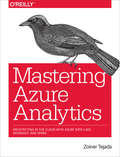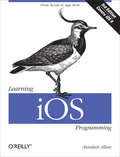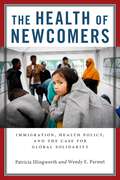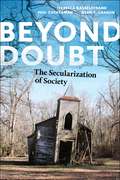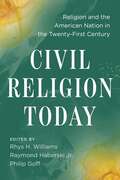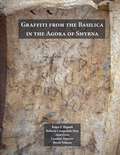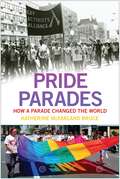- Table View
- List View
Photoshop CC: Covers 2014 Release
by Lesa SniderPhotoshop CC is truly amazing, but it can also be overwhelming if you’re just getting started. This book makes learning Photoshop as easy as possible by explaining things in a friendly, conversational style—without technical jargon. After a thorough introduction to the program, you’ll delve deep into Photoshop’s secrets with expert tips and practical editing advice you can use every day.The important stuff you need to know:Learn your way around. Take a tour of Photoshop’s workspace and learn how to customize it.Unlock the magic. Use layers, masks, and Smart Objects to safely edit your images.Perfect your photos. Learn techniques for cropping, color-correcting, retouching, and combining photos.Master color. Drain, change, and add color; create gorgeous black-and-whites, partial-color effects, and duotones.Be artistic. Create illustrations, paintings, and pro-level text; use filters effectively, edit video, and create 3D art.Share your work. Produce great-looking images for print, presentations, and the Web.Work smarter and faster. Automate common chores and install plug-ins for complex tasks.
Apache: The Definitive Guide, 3rd Edition
by Ben Laurie Peter LaurieApache is far and away the most widely used web server platform in the world. This versatile server runs more than half of the world's existing web sites. Apache is both free and rock-solid, running more than 21 million web sites ranging from huge e-commerce operations to corporate intranets and smaller hobby sites.With this new third edition of Apache: The Definitive Guide, web administrators new to Apache will come up to speed quickly, and experienced administrators will find the logically organized, concise reference sections indispensable, and system programmers interested in customizing their servers will rely on the chapters on the API and Apache modules.Updated to cover the changes in Apache's latest release, 2.0, as well as Apache 1.3, this useful guide discusses how to obtain, set up, secure, modify, and troubleshoot the Apache software on both Unix and Windows systems. Dozens of clearly written examples provide the answers to the real-world issues that Apache administrators face everyday. In addition to covering the installation and configuration of mod_perl and Tomcat, the book examines PHP, Cocoon, and other new technologies that are associated with the Apache web server. Additional coverage of security and the Apache 2.0 API make Apache: The Definitive Guide, Third Edition essential documentation for the world's most popular web server.
"Are You Calling Me a Racist?": Why We Need to Stop Talking about Race and Start Making Real Antiracist Change
by Sarita SrivastavaShows why diversity workshops fail and offers concrete solutions for a path forwardDespite decades of anti-racism workshops and diversity policies in corporations, schools, and nonprofit organizations, racial conflict has only increased in recent years. “Are You Calling Me a Racist?” reveals why these efforts have failed to effectively challenge racism and offers a new way forward.Drawing from her own experience as an educator and activist, as well as extensive interviews and analyses of contemporary events, Sarita Srivastava shows that racial encounters among well-meaning people are ironically hindered by the emotional investment they have in being seen as good people. Diversity workshops devote energy to defending, recuperating, educating, and inwardly reflecting, with limited results, and these exercises often make things worse. These “Feel-Good politics of race,” Srivastava explains, train our focus on the therapeutic and educational, rather than on concrete practices that could move us towards true racial equity. Inthis type of approach to diversity training, people are more concerned about being called a racist than they are about changing racist behavior.“Are You Calling Me a Racist?” is a much-needed challenge to the status quo of diversity training, and will serve as a valuable resource for anyone dedicated to dismantling racism in their communities, educational institutions, public or private organizations, and social movements.
The Urban Church Imagined: Religion, Race, and Authenticity in the City
by Rhys H. Williams Jessica M. BarronExplores the role of race and consumer culture in attracting urban congregants to an evangelical church The Urban Church Imagined illuminates the dynamics surrounding white urban evangelical congregations’ approaches to organizational vitality and diversifying membership. Many evangelical churches are moving to urban, downtown areas to build their congregations and attract younger, millennial members. The urban environment fosters two expectations. First, a deep familiarity and reverence for popular consumer culture, and second, the presence of racial diversity. Church leaders use these ideas when they imagine what a “city church” should look like, but they must balance that with what it actually takes to make this happen. In part, racial diversity is seen as key to urban churches presenting themselves as “in touch” and “authentic.” Yet, in an effort to seduce religious consumers, church leaders often and inadvertently end up reproducing racial and economic inequality, an unexpected contradiction to their goal of inclusivity. Drawing on several years of research, Jessica M. Barron and Rhys H. Williams explore the cultural contours of one such church in downtown Chicago. They show that church leaders and congregants’ understandings of the connections between race, consumer culture, and the city is a motivating factor for many members who value interracial interactions as a part of their worship experience. But these explorations often unintentionally exclude members along racial and classed lines. Indeed, religious organizations’ efforts to engage urban environments and foster integrated congregations produce complex and dynamic relationships between their racially diverse memberships and the cultivation of a safe haven in which white, middle-class leaders can feel as though they are being a positive force in the fight for religious vitality and racial diversity. The book adds to the growing constellation of studies on urban religious organizations, as well as emerging scholarship on intersectionality and congregational characteristics in American religious life. In so doing, it offers important insights into racially diverse congregations in urban areas, a growing trend among evangelical churches. This work is an important case study on the challenges faced by modern churches and urban institutions in general.
The New Immigrant Whiteness: Race, Neoliberalism, and Post-Soviet Migration to the United States (Nation of Nations #10)
by Claudia Sadowski-SmithExplores the racialization of immigrants from post-Soviet states and the nuances of citizenship for this new diaspora. Mapping representations of post-1980s immigration from the former Soviet Union to the United States in interviews, reality TV shows, fiction, and memoirs, Claudia Sadowski-Smith shows how this nationally and ethnically diverse group is associated with idealized accounts of the assimilation and upward mobility of early twentieth-century arrivals from Europe. As it traces the contributions of historical Eastern European migration to the emergence of a white racial identity that continues to provide privileges to many post-Soviet migrants, the book places the post-USSR diaspora into larger discussions about the racialization of contemporary US immigrants under neoliberal conditions. The New Immigrant Whiteness argues that legal status on arrival––as participants in refugee, marriage, labor, and adoptive migration–– impacts post-Soviet immigrants’ encounters with growing socioeconomic inequalities and tightened immigration restrictions, as well as their attempts to construct transnational identities. The book examines how their perceived whiteness exposes post-Soviet family migrants to heightened expectations of assimilation, explores undocumented migration from the former Soviet Union, analyzes post-USSR immigrants’ attitudes toward anti-immigration laws that target Latina/os, and considers similarities between post-Soviet and Asian immigrants in their association with notions of upward immigrant mobility. A compelling and timely volume, The New Immigrant Whiteness offers a fresh perspective on race and immigration in the United States today.
African Archaeology Without Frontiers: Papers from the 2014 PanAfrican Archaeological Association Congress
by Alex Schoeman Chapurukha M Kusimba Santores Tchandeu Dirk Seidensticker Adrianne Daggett Marilee Wood Laure Dussubieux Tim Forssman Kate Smuts Nick Wiltshire Akin Ogundiran Matthew Davies Caleb Adebayo Folorunso Timothy Kipkeu Kipruto Freda M’Mbogori Henrietta L Moore Emubosa Orijemie Festo W Gabriel Elinaza Mjema Philip de Barros Gabriella Lucidi NarcisseConfronting national, linguistic and disciplinary boundaries, contributors to African Archaeology Without Frontiers argue against artificial limits and divisions created through the study of ‘ages’ that in reality overlap and cannot and should not be understood in isolation. Papers are drawn from the proceedings of the landmark 14th PanAfrican Archaeological Association Congress, held in Johannesburg in 2014, nearly seven decades after the conference planned for 1951 was re-located to Algiers for ideological reasons following the National Party’s rise to power in South Africa. Contributions by keynote speakers Chapurukha Kusimba and Akin Ogundiran encourage African archaeologists to practise an archaeology that collaborates across many related fields of study to enrich our understanding of the past. The nine papers cover a broad geographical sweep by incorporating material on ongoing projects throughout the continent including South Africa, Botswana, Cameroon, Togo, Tanzania, Kenya and Nigeria. Thematically, the papers included in the volume address issues of identity and interaction, and the need to balance cultural heritage management and sustainable development derived from a continent racked by social inequalities and crippling poverty. Edited by three leading archaeologists, the collection covers many aspects of African archaeology, and a range of periods from the earliest hominins to the historical period. It will appeal to specialists and interested amateurs.
Vegas Brews: Craft Beer and the Birth of a Local Scene
by Michael Ian BorerAn inside look at how craft beer makers and IPA devotees come together to brew, taste, and enjoy fine ale while also building a sense of community in Las Vegas Equally reviled and revered as Sin City, Las Vegas is both exceptional and emblematic of contemporary American cultural practices and tastes. Michael Ian Borer takes us inside the burgeoning Las Vegas craft beer scene to witness how its adherents use beer to create and foster not just a local culture but a locals’ culture. Through compelling, detailed first-hand accounts and interviews, Vegas Brews provides an unprecedented look into the ways that brewers, distributors, bartenders, and drinkers fight against the perceived and preconceived norm about what “happens in Vegas” and lay claim to a part of their city that is too often overshadowed by the bright lights of tourist sites. Borer shows how our interactions with the things we care about—and the ways that we care about how they’re made, treated, and consumed—can lead to new senses of belonging and connections with and to others and the places where we live.In a world where people and things move around at an extraordinary pace, the folks Borer spent time talking (and drinking) with remind us to slow down and learn how to taste the “good life,” or at least a semblance of it, even in a city where style is often valued over substance.
Students Must Rise: Youth struggle in South Africa before and beyond Soweto '76
by Anne Heffernan and Noor NieftagodienA detailed account of the incredibly influential Soweto Student Uprising of 1976The Soweto Student Uprising of 1976 was a decisive moment in the struggle against apartheid. It marked the expansion of political activism to a new generation of young activists, but beyond that it inscribed the role that young people of subsequent generations could play in their country's future. Since that momentous time students have held a special place in the collective imaginary of South African history. Drawing on research and writing by leading scholars and prominent activists, Students Must Rise takes Soweto '76 as its pivot point, but looks at student and youth activism in South Africa more broadly by considering what happened before and beyond the Soweto moment. Early chapters assess the impact of the anti-pass campaigns of the 1950s, of political ideologies like black consciousness as well as of religion and culture in fostering political consciousness and organisation among youth and students in townships and rural areas. Later chapters explore the wide-reaching impact of June 16th itself for student organisation over the next two decades across the country. Two final chapters consider contemporary student-based political movements, including #RhodesMustFall and #FeesMustFall, and historically root these in the long and rich tradition of student activism in South Africa. 2016 marks the 40th anniversary of the 1976 June 16th uprisings. This book rethinks the conventional narrative of youth and student activism in South Africa by placing that most famous of moments - the 1976 students' uprising in Soweto - in a deeper historical and geographic context.
Programming ColdFusion MX: Creating Dynamic Web Applications
by Rob Brooks-BilsonColdFusion has enjoyed widespread use among developers as a powerful, easy-to-learn platform for creating and deploying dynamic web applications. ColdFusion's simple, tag-based language makes it easy to handle basic tasks, like processing form data and querying databases, but the language is also powerful enough to deliver highly scalable, robust applications. And now that Macromedia has integrated ColdFusion into its MX family of technologies, ColdFusion is capable of interacting with Flash MX applications, which opens up even more possibilities.The first edition of this book has been praised as "the best reference book available on the subject." This new edition, Programming ColdFusion MX, 2nd Edition, goes even further, documenting new techniques for using ColdFusion MX 6.1 to develop and serve dynamic web page content. This exhaustive guide covers everything from the basics to advanced topics, with numerous examples that you can use for your own applications. Contents include:Sharing application data using the web application framework and shared scope variablesAccessing databases, maintaining database records, and advanced database techniques such as drill-down queries, query caching, and query of queriesIntegrating applications with ColdFusion MX's new security frameworkInteracting with other data sources, including LDAP directories, email servers, and other web serversExtending ColdFusion with user-defined functions (UDFs), custom tags, and ColdFusion Components (CFCs)Advanced topics such as working with XML, consuming and producing web services, and integrating ColdFusion with Flash via Flash RemotingReference material for all the tags and functions that comprise CFML, the ColdFusion Markup LanguageProgramming ColdFusion MX, 2nd Edition, covers ColdFusion MX 6.1, the latest release of ColdFusion, and is packed with advanced strategies, insider hints, tips, and tricks for creating effective web applications. If you are a ColdFusion developer, you need this book to help you make the most out of ColdFusion MX.
Web Operations: Keeping the Data On Time
by John Allspaw Jesse RobbinsA web application involves many specialists, but it takes people in web ops to ensure that everything works together throughout an application's lifetime. It's the expertise you need when your start-up gets an unexpected spike in web traffic, or when a new feature causes your mature application to fail. In this collection of essays and interviews, web veterans such as Theo Schlossnagle, Baron Schwartz, and Alistair Croll offer insights into this evolving field. You'll learn stories from the trenches--from builders of some of the biggest sites on the Web--on what's necessary to help a site thrive.Learn the skills needed in web operations, and why they're gained through experience rather than schoolingUnderstand why it's important to gather metrics from both your application and infrastructureConsider common approaches to database architectures and the pitfalls that come with increasing scaleLearn how to handle the human side of outages and degradationsFind out how one company avoided disaster after a huge traffic delugeDiscover what went wrong after a problem occurs, and how to prevent it from happening againContributors include:John AllspawHeather ChampMichael ChristianRichard CookAlistair CrollPatrick DeboisEric FlorenzanoPaul HammondJustin HuffAdam JacobJacob LoomisMatt MassieBrian MoonAnoop NagwaniSean PowerEric RiesTheo SchlossnagleBaron SchwartzAndrew Shafer
Head First Physics: A learner's companion to mechanics and practical physics (AP Physics B - Advanced Placement) (Head First)
by Heather LangWouldn't it be great if there were a physics book that showed you how things work instead of telling you how? Finally, with Head First Physics, there is. This comprehensive book takes the stress out of learning mechanics and practical physics by providing a fun and engaging experience, especially for students who "just don't get it."Head First Physics offers a format that's rich in visuals and full of activities, including pictures, illustrations, puzzles, stories, and quizzes -- a mixed-media style proven to stimulate learning and retention. One look will convince you: This isn't mere theory, this is physics brought to life through real-world scenarios, simple experiments, and hypothetical projects. Head First Physics is perfect for anyone who's intrigued by how things work in the natural world.You'll quickly discover that physics isn't a dry subject. It's all about the world we live in, encompassing everything from falling objects and speeding cars, to conservation of energy and gravity and weightlessness, and orbital behavior. This book:Helps you think like a physicist so you can understand why things really work the way they doGives you relevant examples so you can fully grasp the principles before moving on to more complex conceptsDesigned to be used as a supplement study guide for the College Board's Advanced Placement Physics B ExamIntroduces principles for the purpose of solving real-world problems, not memorizationTeaches you how to measure, observe, calculate -- and yes -- how to do the mathCovers scientific notation, SI units, vectors, motion, momentum conservation, Newton's Laws, energy conservation, weight and mass, gravitation and orbits, circular motion and simple harmonic motion, and much moreIf "Myth Busters" and other TV programs make you curious about our physical world -- or if you're a student forced to take a physics course -- now you can pursue the subject without the dread of boredom or the fear that it will be over your head. Head First Physics comes to rescue with an innovative, engaging, and inspirational way to learn physics!
The Art of SQL
by Stephane Faroult Peter RobsonFor all the buzz about trendy IT techniques, data processing is still at the core of our systems, especially now that enterprises all over the world are confronted with exploding volumes of data. Database performance has become a major headache, and most IT departments believe that developers should provide simple SQL code to solve immediate problems and let DBAs tune any "bad SQL" later.In The Art of SQL, author and SQL expert Stephane Faroult argues that this "safe approach" only leads to disaster. His insightful book, named after Art of War by Sun Tzu, contends that writing quick inefficient code is sweeping the dirt under the rug. SQL code may run for 5 to 10 years, surviving several major releases of the database management system and on several generations of hardware. The code must be fast and sound from the start, and that requires a firm understanding of SQL and relational theory.The Art of SQL offers best practices that teach experienced SQL users to focus on strategy rather than specifics. Faroult's approach takes a page from Sun Tzu's classic treatise by viewing database design as a military campaign. You need knowledge, skills, and talent. Talent can't be taught, but every strategist from Sun Tzu to modern-day generals believed that it can be nurtured through the experience of others. They passed on their experience acquired in the field through basic principles that served as guiding stars amid the sound and fury of battle. This is what Faroult does with SQL.Like a successful battle plan, good architectural choices are based on contingencies. What if the volume of this or that table increases unexpectedly? What if, following a merger, the number of users doubles? What if you want to keep several years of data online? Faroult's way of looking at SQL performance may be unconventional and unique, but he's deadly serious about writing good SQL and using SQL well. The Art of SQL is not a cookbook, listing problems and giving recipes. The aim is to get you-and your manager-to raise good questions.
Microservice Architecture: Aligning Principles, Practices, and Culture
by Mike Amundsen Ronnie Mitra Irakli Nadareishvili Matt McLartyMicroservices can have a positive impact on your enterprise—just ask Amazon and Netflix—but you can fall into many traps if you don’t approach them in the right way. This practical guide covers the entire microservices landscape, including the principles, technologies, and methodologies of this unique, modular style of system building. You’ll learn about the experiences of organizations around the globe that have successfully adopted microservices.In three parts, this book explains how these services work and what it means to build an application the Microservices Way. You’ll explore a design-based approach to microservice architecture with guidance for implementing various elements. And you’ll get a set of recipes and practices for meeting practical, organizational, and cultural challenges to microservice adoption.Learn how microservices can help you drive business objectivesExamine the principles, practices, and culture that define microservice architecturesExplore a model for creating complex systems and a design process for building a microservice architectureLearn the fundamental design concepts for individual microservicesDelve into the operational elements of a microservices architecture, including containers and service discoveryDiscover how to handle the challenges of introducing microservice architecture in your organization
DNS and BIND on IPv6: DNS for the Next-Generation Internet
by Cricket LiuIf you're preparing to roll out IPv6 on your network, this concise book provides the essentials you need to support this protocol with DNS. You'll learn how DNS was extended to accommodate IPv6 addresses, and how you can configure a BIND name server to run on the network. This book also features methods for troubleshooting problems with IPv6 forward- and reverse-mapping, and techniques for helping islands of IPv6 clients communicate with IPv4 resources.Topics include:DNS and IPv6—Learn the structure and representation of IPv6 addresses, and the syntaxes of AAAA and PTR records in the ip6.arpa IPv6 reverse-mapping zoneBIND on IPv6—Use IPv6 addresses and networks in ACLs, and register and delegate to IPv6-speaking name serversResolver Configuration—Configure popular stub resolvers (Linux/Unix, MacOS X, and Windows) to query IPv6-speaking name serversDNS64—Learn about the transition technology that allows clients with IPv6-only network stacks to communicate with IPv4 serversTroubleshooting—Use the nslookup and dig troubleshooting tools to look up the IPv6 addresses of a domain name, or reverse-map an IPv6 address to a domain name
XML Publishing with Adobe InDesign
by Dorothy J. HoskinsFrom Adobe InDesign CS2 to InDesign CS5, the ability to work with XML content has been built into every version of InDesign. Some of the useful applications are importing database content into InDesign to create catalog pages, exporting XML that will be useful for subsequent publishing processes, and building chunks of content that can be reused in multiple publications.In this Short Cut, we’ll play with the contents of a college course catalog and see how we can use XML for course descriptions, tables, and other content. Underlying principles of XML structure, DTDs, and the InDesign namespace will help you develop your own XML processes. We’ll touch briefly on using InDesign to “skin” XML content, exporting as XHTML, InCopy, and the IDML package. The Advanced Topics section gives tips on using XSLT to manipulate XML in conjunction with InDesign.
Mastering Azure Analytics: Architecting in the Cloud with Azure Data Lake, HDInsight, and Spark
by Zoiner TejadaMicrosoft Azure has over 20 platform-as-a-service (PaaS) offerings that can act in support of a big data analytics solution. So which one is right for your project? This practical book helps you understand the breadth of Azure services by organizing them into a reference framework you can use when crafting your own big data analytics solution.You’ll not only be able to determine which service best fits the job, but also learn how to implement a complete solution that scales, provides human fault tolerance, and supports future needs.Understand the fundamental patterns of the data lake and lambda architectureRecognize the canonical steps in the analytics data pipeline and learn how to use Azure Data Factory to orchestrate themImplement data lakes and lambda architectures, using Azure Data Lake Store, Data Lake Analytics, HDInsight (including Spark), Stream Analytics, SQL Data Warehouse, and Event HubsUnderstand where Azure Machine Learning fits into your analytics pipelineGain experience using these services on real-world data that has real-world problems, with scenarios ranging from aviation to Internet of Things (IoT)
Learning iOS Programming: From Xcode to App Store
by Alasdair AllanGet a rapid introduction to iPhone, iPad, and iPod touch programming. With this easy-to-follow guide, you’ll learn how to develop your first marketable iOS application, from opening Xcode to submitting your product to the App Store. Whether you’re a developer new to Mac programming or an experienced Mac developer ready to tackle iOS, this is your book.You’ll learn about Objective-C and the core frameworks hands-on by writing several sample iOS applications, giving you the basic skills for building your own applications independently. Packed with code samples, this book is refreshed and updated for iOS 6 and Xcode 4.Discover the advantages of building native iOS appsGet started with Objective-C and the Cocoa Touch frameworksDive deep into the table view classes for building user interfacesHandle data input, parse XML and JSON documents, and store data on SQLiteUse iOS sensors, including the accelerometer, magnetometer, camera, and GPSBuild apps that use the Core Location and MapKit frameworksIntegrate Apple’s iCloud service into your applicationsWalk through the process of distributing your polished app to the App Store
Repairing and Upgrading Your PC
by Robert Bruce Thompson Barbara Fritchman ThompsonMost computer users think that fiddling with the insides of their PC is taboo. They fear that by removing the screws that hold the case on, they're crossing into forbidden territory. And even for those who know they can open the box and fix or upgrade their PC, analysis paralysis often stops them in their tracks: Which upgrades offer the best bang for the buck? How do you pinpoint the faulty component that's making your system freeze? What about compatibility issues?Get ready to get unstuck and get your PC running fast and running right. Repairing and Upgrading Your PC delivers start-to-finish instructions, simple enough for even the most inexperienced PC owner, for troubleshooting, repairing, and upgrading your computer. Written by hardware experts Robert Bruce Thompson and Barbara Fritchman Thompson, this book covers it all: how to troubleshoot a troublesome PC, how to identify which components make sense for an upgrade, and how to tear it all down and put it back together. This book shows how to repair and upgrade all of your PC's essential components:Motherboard, CPU, and Memory. Choose the optimal match of these core components to keep your PC running at top speedHard Drive, Optical Drive, and Removable StorageGive your computer what it needs for long-term and short-term storageAudio and Video. Enhance your computing experience with the right sound and graphics devices for your needsInput Devices. Pick the best keyboard and mouse to keep your hands happy and healthyNetworking. Set up secure wireless networking to keep the bits flowing between your computers and the outside worldCases and Power Supplies. Keep everything running cool and reliablyWith its straightforward language, clear instructions, and extensive illustrations, this book makes it a breeze for PC owners of any skill level to work on their computer.
The Health of Newcomers: Immigration, Health Policy, and the Case for Global Solidarity
by Patricia Illingworth Wendy E. ParmetImmigration and health care are hotly debated and contentious issues. Policies that relate to both issues—to the health of newcomers—often reflect misimpressions about immigrants, and their impact on health care systems. Despite the fact that immigrants are typically younger and healthier than natives, and that many immigrants play a vital role as care-givers in their new lands, native citizens are often reluctant to extend basic health care to immigrants, choosing instead to let them suffer, to let them die prematurely, or to expedite their return to their home lands. Likewise, many nations turn against immigrants when epidemics such as Ebola strike, under the false belief that native populations can be kept well only if immigrants are kept out. In The Health of Newcomers, Patricia Illingworth and Wendy E. Parmet demonstrate how shortsighted and dangerous it is to craft health policy on the basis of ethnocentrism and xenophobia. Because health is a global public good and people benefit from the health of neighbor and stranger alike, it is in everyone’s interest to ensure the health of all. Drawing on rigorous legal and ethical arguments and empirical studies, as well as deeply personal stories of immigrant struggles, Illingworth and Parmet make the compelling case that global phenomena such as poverty, the medical brain drain, organ tourism, and climate change ought to inform the health policy we craft for newcomers and natives alike.
Psychodynamic Psychotherapy in South Africa: Contexts, theories and applications
by Cora Smith, Glenys Lobban and Michael O’LoughlinAn accessible text for practitioners, students, and non-specialists about the practice of psychotherapy in South Africa.Psychoanalysis as a long term modality is inaccessible to the average South African. In this book the authors describe how psychoanalytically orientated or psychodynamic psychotherapy can be practiced as a short-term endeavour and applied to contemporary issues facing the country. Psychodynamic work is currently undertaken by clinical psychologists, therapists, clinicians, trainers, teachers, clinical supervisors, consultants and researchers working in university settings, state hospitals, community projects, private practice and research. The debates, clinical issues, therapeutic practice and nature of research covered in the book are widely representative of the work being done in the country. The need for shorter term therapy models and evidence-based interventions is as acute in global practice as it is locally. The lessons learned in South Africa have broader implications for international practitioners, and the authors stress the potential inherent in psychoanalytic theory and technique to tackle the complex problems faced in all places and settings characterised by increasing globalisation and dislocation. The book is structured in three main sections. Psychodynamic Psychotherapy in South Africa is aimed at local and international practitioners and students, while non-specialist readers will find the text informative and accessible.
Beyond Doubt: The Secularization of Society (Secular Studies #7)
by Phil Zuckerman Ryan T. Cragun Isabella KasselstrandDemonstrates definitively that the secularization thesis is correct, and religion is losing its grip on societies worldwideIn the decades since its introduction, secularization theory has been subjected to doubt and criticism from a number of leading scholars, who have variously claimed that it is wrong, flawed, or incomplete. In Beyond Doubt, Isabella Kasselstrand, Phil Zuckerman, and Ryan T. Cragun mount a strong defense for the theory, providing compelling evidence that religion is indeed declining globally as a result of modernization. Though defenses of secularization theory have been mounted in the past, we now have many years’ worth of empirical data to illuminate trends, and can trace changes not just at a given point in time but over a trajectory. Drawing on extensive survey data from nations around the world, the book demonstrates that, in spite of its many detractors, there is robust empirical support for secularization theory. It also engages with the most prominent criticisms levied against the theory, showing that data that are said to refute the narrative of religious decline are easily explainable and in keeping with the broader tendency toward secularization. Beyond simply defending secularization theory, the authors endeavor to formalize it, offering clear definitions of relevant terms and creating propositions that can be repeatedly and accurately tested. Beyond Doubt offers the strongest argument to date for the existence of a global secularization trend, and will be a vital resource for students and scholars alike who study religion and secularism.
Falling in Love with Nature: The Values of Latinx Catholic Environmentalism (North American Religions)
by Amanda J. BaughExplores the contours of Latinx Catholic environmentalismHome-based conservationist measures such as cultivating backyard gardens, avoiding consumerism, and limiting waste are widespread among Spanish-speaking Catholics across the United States. Yet these home-based conservationist practices are seldom recognized as “environmental” because they are enacted by working-class immigrant communities and do not conform to the expectations of mainstream environmentalism.In Falling in Love with Nature, Amanda J. Baugh tells the story of American environmentalism through a focus on Spanish-speaking Catholics, shedding light on environmental actors who have been hidden in plain sight. While dominant narratives about environmental activism include minorities, primarily in the realm of environmental racism and injustice, Baugh demonstrates that minority communities are not merely victims of environmental problems. They can be active agents who express love for nature based on inherited family traditions and close relationships with the land. Baugh shows that Spanish-speaking Catholics have values that have been overlooked in global discourses, grassroots movements, and the highest echelons of the US Catholic Church. By drawing attention to the environmental knowledge that is already abundant within Spanish-speaking Catholic communities, Falling in Love with Nature challenges readers to rethink their assumptions about who can be an environmental leader and what counts as environmentalism.
Civil Religion Today: Religion and the American Nation in the Twenty-First Century
by Philip Goff Rhys H. Williams Raymond Haberski Jr.Moves the discussion of American civil religion into the twenty-first century Civil Religion, a term made popular by sociologist Robert Bellah a little over fifty years ago, describes how people might share in a sacred sense of their nation. While hotly debated, the idea continues to enjoy wide application among academics and journalists. Bellah used civil religion to make sense of the turmoil of the 1960s, especially moral debates provoked by the Vietnam War. Now, a half-century later, American society is again riven by conflict over immigration, economic inequality, racial oppression, and “culture wars” issues. Is Bellah's hopeful assessment still useful for understanding contemporary America? If not, how should we think of it differently?Civil Religion Today reassesses the term to take stock of its usefulness after fifty years of engagement in the field. Looking both at the concept and at ground-level studies of how we might find civil religion in practice, this book aims to push the conversation forward, considering how and in what ways it is helpful in our current social and political context, evaluating which parts are worth keeping, which can be reformulated, and which can now be usefully discarded. It suggests we go “beyond Bellah” in theory and practice, thinking about American society in a new century.
Graffiti from the Basilica in the Agora of Smyrna (ISAW Monographs #1)
by Roger S. Bagnall, Roberta Casagrande-Kim, Akın Ersoy, and Cumhur TanrıverAn in-depth archaeological reportfeaturing graffiti found during a recent excavation at the Ancient Greek cityof Smyrna. The graffiti published in this richly-illustrated volume were discovered during an excavation of the Roman basilica in the Ancient Greek city of Smyrna, known today as Izmir, which is situated on the Aegean coast of modern Turkey. The project, which began in 2003, has unearthed a multitude of graffiti and drawings encompassing a wide range of subjects and interests, including local politics, nautical vessels, sex, and wordplay. Each graffito artifact holds the potential for vast historical and cultural data, rescued in this volume from the passage of time and razing ambitions of urban development. Given the city’s history, the potential wealth of knowledge to be gleamed from these discoveries is substantial: Smyrna has an uninterrupted history of settlement since the Neolithic–Copper ages, and remains today a major city and Mediterranean seaport at the crossroads of key trade routes. The present volume provides comprehensive editions of the texts, descriptions of the drawings, and an extensive introduction to the subjects of the graffiti, how they were produced, and who was responsible for them. A complete set of color photographs is included.
Pride Parades: How a Parade Changed the World
by Katherine McFarland BruceOn June 28, 1970, two thousand gay and lesbian activists in New York, Los Angeles, and Chicago paraded down the streets of their cities in a new kind of social protest, one marked by celebration, fun, and unashamed declaration of a stigmatized identity. Forty-five years later, over six million people annually participate in 115 Pride parades across the United States. They march with church congregations and college gay-straight alliance groups, perform dance routines and marching band numbers, and gather with friends to cheer from the sidelines. With vivid imagery, and showcasing the voices of these participants, Pride Parades tells the story of Pride from its beginning in 1970 to 2010. Though often dismissed as frivolous spectacles, the author builds a convincing case for the importance of Pride parades as cultural protests at the heart of lesbian, gay, bisexual, and transgender (LGBT) community. Weaving together interviews, archival reports, quantitative data, and ethnographic observations at six diverse contemporary parades in New York City, Salt Lake City, San Diego, Burlington, Fargo, and Atlanta, Bruce describes how Pride parades are a venue for participants to challenge the everyday cultural stigma of being queer in America, all with a flair and sense of fun absent from typical protests. Unlike these political protests that aim to change government laws and policies, Pride parades are coordinated, concerted attempts to improve the standing of LGBT people in American culture.
